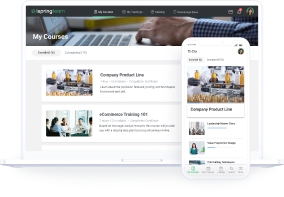The Best Employee Training Software for a Modern Workplace

Everyone who has ever been in the L&D field knows that turning an average performer into a top talent doesn’t happen by chance. It takes strategic learning, meaningful development opportunities, and, crucially, the right training software to support all this.
To help you navigate literally thousands of options, we’ve done the research and identified the best employee training software available in 2025 — based on key criteria for training managers (ease of use, mobile access, advanced reporting, and training automation.)
We also invited Alexander Salas, a certified T&D professional and technical trainer, to weigh in and share his perspective on what truly makes a training platform effective in achieving organizational growth. Click on any tool below that seems more relevant for you, or continue reading to get the scoop on each employee training software for a modern workplace.
| Employee training software | Best for | Starting price | Free trial |
| 1. iSpring LMS | Employee development and training programs. Shines for its ease of use, high security, and built-in content authoring. | $4.46 per active user/month | 30 days |
| 2. LearnUpon | Running blended training programs and training various audiences under one roof. | Upon request |  |
| 3. Docebo | Managing long-term online L&D programs and personalizing training with AI-driven recommendations. | Upon request |  |
| 4. eFront | Enterprise-level customization and flexibility | $720/month |  |
| 5. Bridge | Workplace training, performance evaluations, and aligning individual goals with the organization’s priorities. | Upon request |  |
| 6. Absorb | Training and upskilling employees, customers, and partners around the globe. | Upon request | 10 days |
| 7. TalentLMS | Selling courses online, delivering both internal and external training. | $109/month | Free plan |
| 8. Whatfix | Digital product onboarding and induction training in enterprises where multiple software applications are used. | Upon request |  |
| 9. Litmos | Learning management and off-the-shelf courses, especially for compliance training in specific industries. | Upon request | 14 days |
| 10. Skillsoft | Ready-made online training courses for employees; personalized learning paths tailored to employee career goals and growth objectives. | Upon request | 14–45 days, depending on the plan |
| 11. LearnWorlds | Selling training programs and onboarding new hires on the same platform. | $24/month | 30 days |
Types of Employee Training Software
When organizations want to upskill their teams, they typically turn to one of the following types of employee training software or a combination of two or more:
1. Learning management systems (LMSs)
LMSs are centralized platforms for managing, delivering, and tracking employee training programs. The main functionalities include course creation, content and user management, progress tracking, reporting, and analytics.
Examples: iSpring LMS, TalentLMS, Absorb LMS
2. Learning experience platforms (LXPs)
LXPs are personalized learning environments that focus on user experience and engagement. The key features include AI-driven content recommendations, social learning, user-generated content, and integration with various content sources.
Examples: Degreed, EdCast, Cornerstone OnDemand
3. Microlearning platforms
These employee training apps help deliver training content in short, focused segments to enhance knowledge retention and learner engagement. Their main features are the creation of bite-sized lessons, mobile accessibility for completing training at one’s own pace, and gamification, which makes online learning fun.
Examples: Axonify, Grovo, Qstream
4. Virtual classroom software
Also known as video-conferencing tools, they allow trainers to conduct real-time, interactive online training sessions. The main functionalities are live video conferencing, screen sharing, breakout rooms, interactive whiteboards, and recording capabilities.
Examples: Zoom, Microsoft Teams, Adobe Connect
5. eLearning authoring tools
eLearning authoring software enables trainers and course developers to create eLearning content for training programs. The main features include multimedia integration, interactive content, and SCORM compliance.
Examples: iSpring Suite AI, Articulate Storyline, Adobe Captivate

In this guide, we’ll focus on learning management systems (LMSs). They remain the most widely adopted solution for corporate training, and for good reason. A solid LMS usually covers everything you need: course creation, training content delivery, mobile access, virtual classroom support, learner tracking — the whole package. That’s what makes it a go-to choice for many L&D teams looking to run effective training programs.
How to Choose Employee Training Software
Before you start choosing employee training software, it’s advisable to do some groundwork. These steps might seem simple, but skipping them can lead to picking an LMS that doesn’t align with your budget, requirements, or, most importantly, your team’s learning needs.
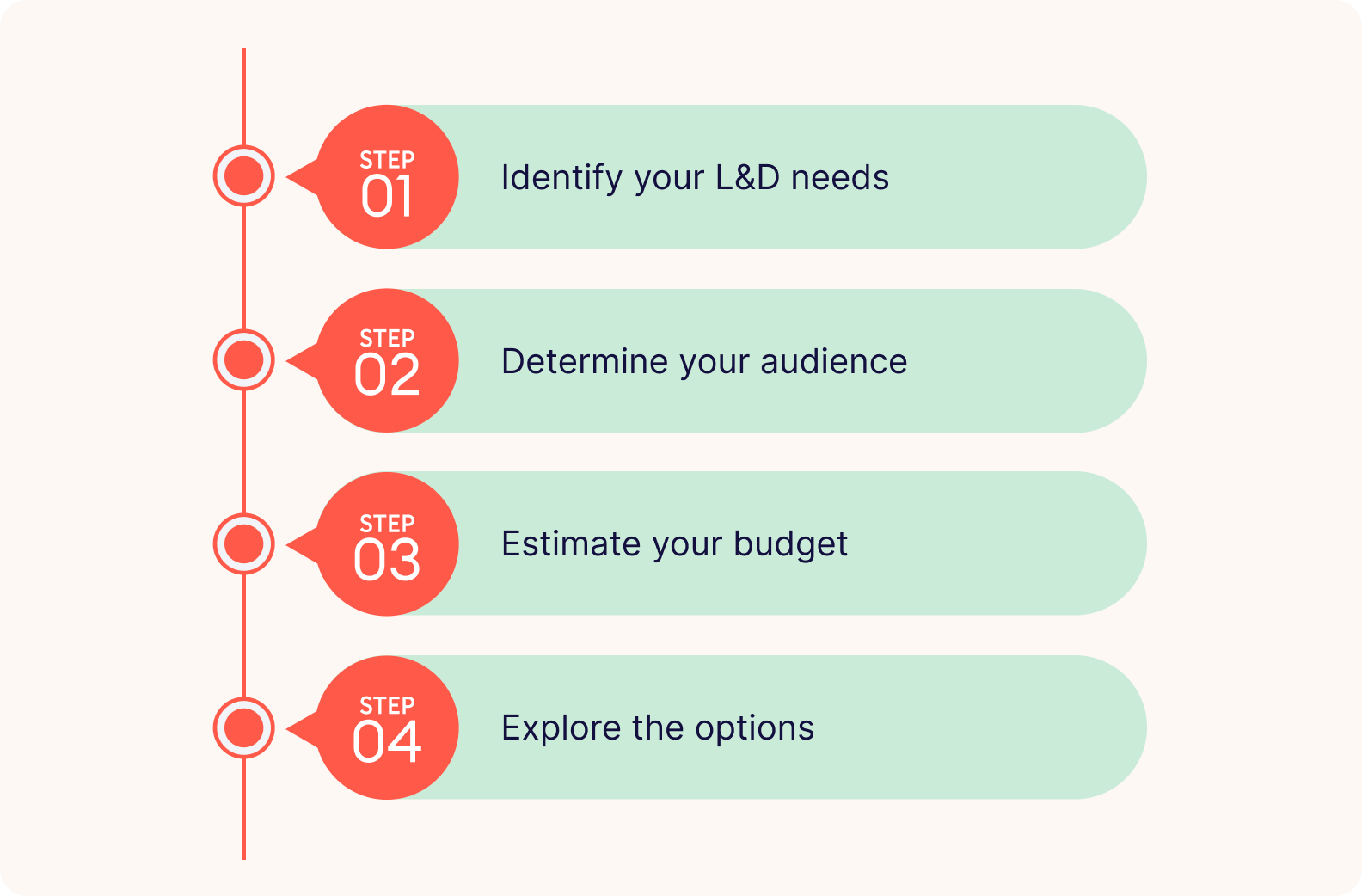
Identify your L&D needs
Are you focusing on employee onboarding, safety training, skill improvement, or a combination of these? Keep in mind that certain LMS platforms are more specialized, like those tailored for the onboarding process. So, before you start assessing different platforms, clearly define the purpose — what you intend to achieve with your training programs.
Determine your audience
Consider your employees’ learning styles, tech-savviness, and work arrangements — are they primarily office-based or remote? This will help you find the most effective content formats and preferred training devices, and engage employees in their learning journey.
Estimate your budget
For small businesses, cost considerations are particularly important. You may prefer to avoid enterprise-oriented platforms or solutions with inflexible pricing plans that include unnecessary features and can’t be customized. This step will help you narrow down your options to software that offers the right balance of affordability and essential features for your training programs.
Explore the options
Most vendors offer free trials and provide live demonstrations to showcase employee training software functionality and discuss your case. So, don’t rush into a purchasing decision. Instead, take advantage of these opportunities to test multiple options and compare their features, user experience, and suitability for your training programs.
As L&D expert Alexander Salas notes, the lack of a free trial paired with a complicated sales process can be a red flag:
“A sales workflow that requires one to talk to the sales team prior to having a free trial usually means the ‘sales process’ is set to distract you from the product’s issues.”
Once you’ve gone through all the steps of the employee training software selection process, you’ll be equipped to make an informed decision and choose software that supports your training objectives effectively, enhances employee engagement, and maximizes the return on your investment (ROI).
What to Look for When Choosing Employee Training Software
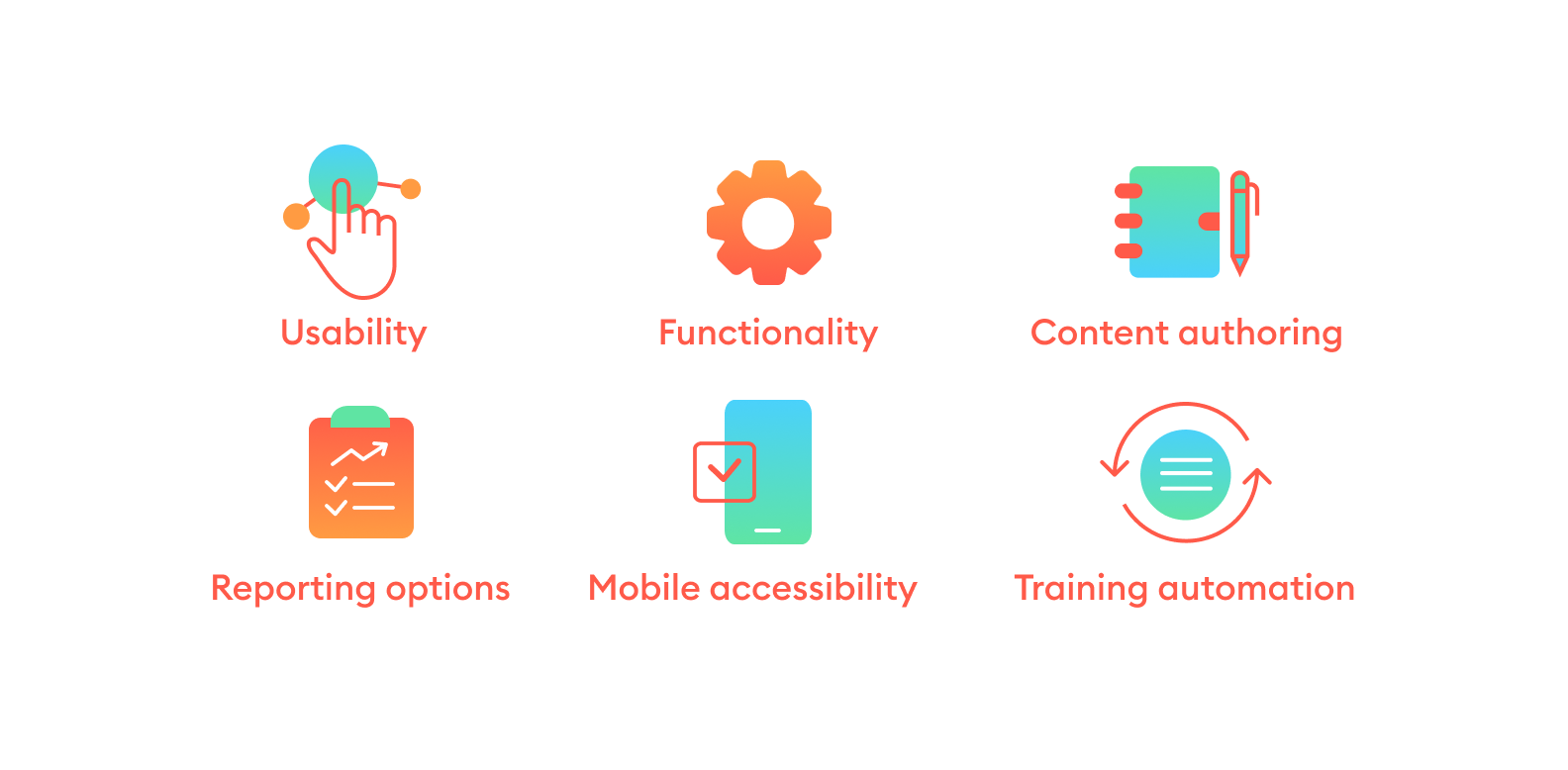
- Usability. The learning and development platform should provide intuitive training management features and facilitate easy course creation. In this way, employees will enjoy a seamless training experience, without having to spend hours learning how to navigate the software.
- Functionality. This covers a range of core features, such as the opportunity to create learning paths, store training materials in the knowledge base, or integrate the learning platform with other software in your toolbox. Some platforms might also feature built-in course builders.
- Content authoring. Do you need to create online employee training courses, or is it sufficient to use ready-made collections? If you plan to roll out brief courses quickly and constantly develop training content in-house, opt for a training platform that’s integrated with content creation tools. LMS industry leaders often provide a built-in authoring functionality, so your subject matter experts can create guides, tutorials, and courses quickly.
- Reporting options. Advanced analytics help you track learner progress with detailed, real-time reports on individual or team results and allow you to make informed decisions about training effectiveness.
- Mobile accessibility. It’s better to use software that’s also accessible on tablets and smartphones. This makes learning more flexible, because learners can access training and close their knowledge gaps faster, at their own pace.
- Training automation. This refers to the system’s ability to streamline training routines without constant manual effort, which allows HR managers to use their time for more important tasks. Primary features might include the automatic assignment of learning modules, learning scheduling, due date reminders, and automated grading systems.
Alexander Salas highlights the broader perspective:
“L&D leaders should prioritize running an inventory of its tech stack, reducing redundant expenses, and enabling powerful integrations by way of AI. Every department should have a custom-trained GPT by 2030.”
Selecting employee online training software that’s aligned with this forward-thinking approach ensures that your training strategy remains relevant and impactful for years to come.
The 11 Best Employee Training Software to Consider in 2025
Here you’ll find a detailed overview of each platform on our list, including their pros, cons, the most common use cases, and pricing details.
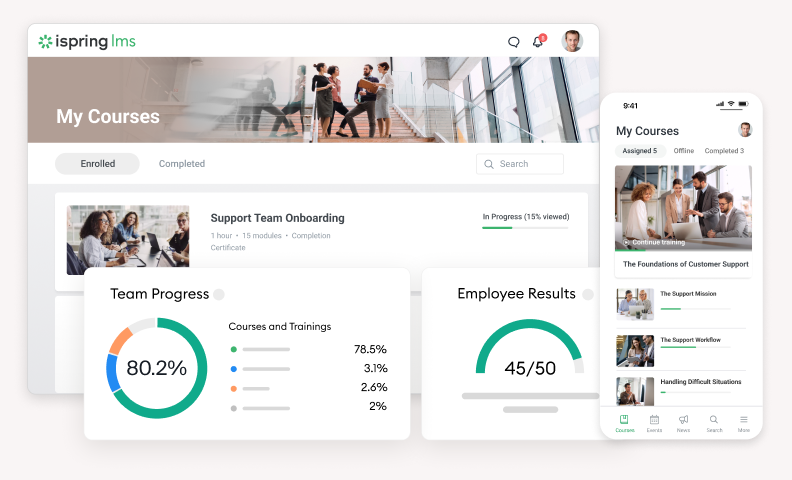
Why we picked it
iSpring LMS is an employee online training software that takes the top spot in our ranking for its highly intuitive design and robust feature set that supports any learning scenario, from new hire onboarding and employee certifications to product training and compliance training.
This training software stands out because of its impressive authoring capabilities: iSpring LMS features built-in course creation and comes bundled with the iSpring Suite authoring tool, making the LMS fully self-sufficient. Learning managers will also appreciate the training automation that handles all of the tedious routines, like assignments and reminders about events, courses, or upcoming deadlines.
As a robust corporate LMS, iSpring LMS goes beyond the basics. Its Development Plans module helps streamline onboarding and long-term employee growth through checklists, task assignments, and mentorship tracking. Other notable features include 360-degree performance reviews, an interactive knowledge base, and a corporate portal with org charts, employee profiles, and a newsfeed.
Pros
- Mobile app for iOS and Android with impressive performance
- Unlimited storage and administrators
- SCORM and xAPI support
- Instructor-led training programs (ILT support)
- Intuitive interface
- Advanced analytics with 25+ real-time and scheduled reports on progress
- Structured, easy-to-follow learning tracks
- Training modules can be built directly on the platform or with iSpring Suite
- Responsive 24/7 customer support
- On-premise installation
Cons
- No multi-tenancy support
- No freelance, academic, and non-profit discounts
Pricing
Compared to most competitors, this is the best employee training software in terms of a transparent pricing model, which means no hidden or unexpected fees will come up. Plus, you only pay for active users (those who access the platform in a given month):
- 300 users — $4.46 per user/month.
- 500 users — $3.97 per user/month.
- 1000 users — $3.58 per user/month.
Billed annually. A free 30-day trial and a live, personalized demo are available.
Best for
iSpring LMS is the best employee training software for enterprises looking for a reliable platform with on-premise installation or a rich feature set that goes beyond LMS functionality. On the other hand, it’s also a great employee training software for small businesses that are new to eLearning and want to implement an employee training platform quickly.
Our hands-on take
Working closely with iSpring LMS every day, I still appreciate how intuitive and clean the interface is — even new team members pick it up right away, regardless of their degree of tech expertise. I use the reporting tools often; they’re flexible and powerful, although it can take a minute to find the exact slice of data I’m after.
I also love how smooth the mobile app feels — no glitches, just easy learning on the go. Overall, it’s a solid, user-friendly platform that delivers on its promises.
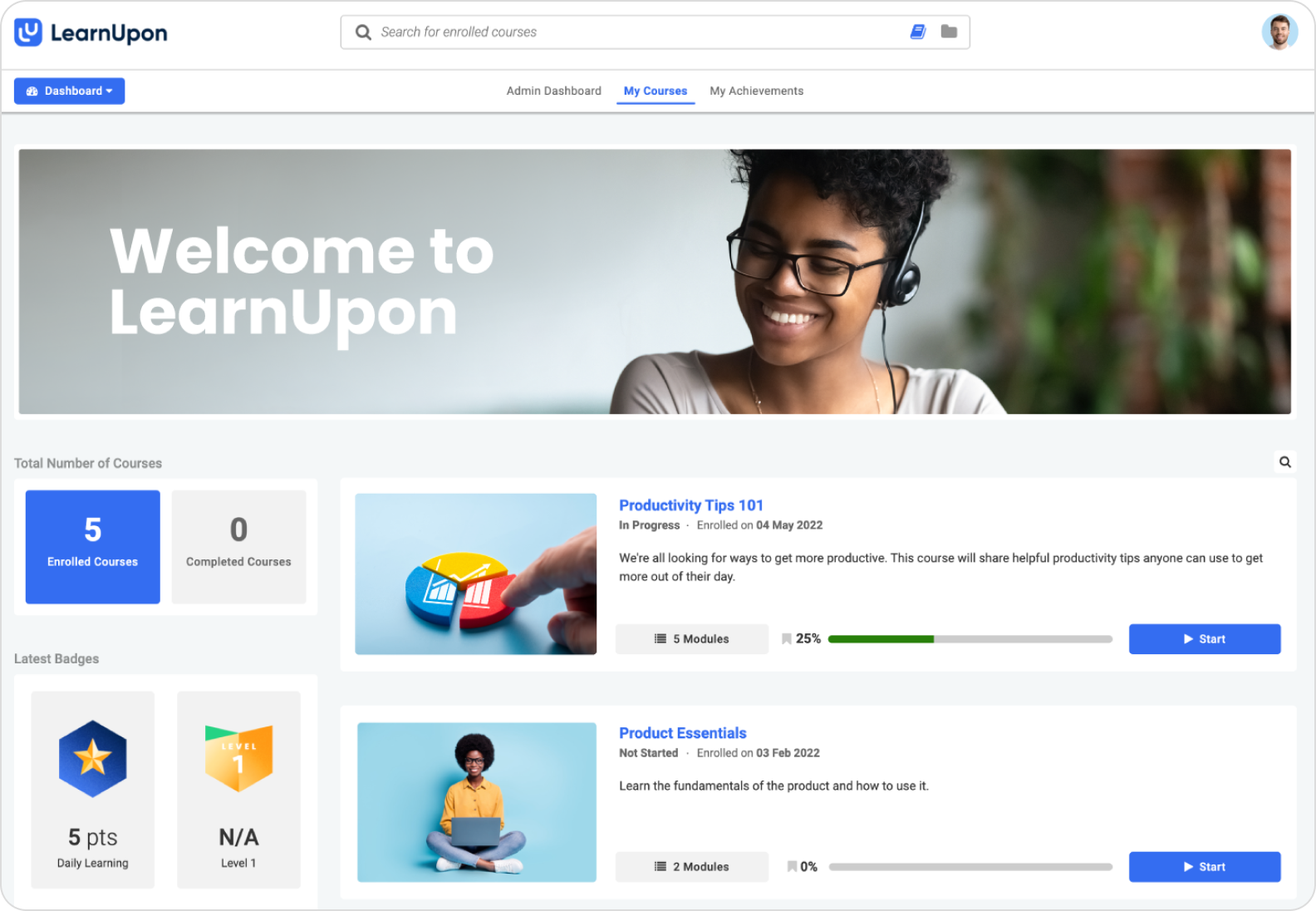
Why we picked it
The LearnUpon LMS is a cloud-based training system for enterprises. Like TalentLMS, it allows you to create independent portals to train various audiences.
You can make eLearning courses mandatory with automated enrollment based on user groups or allow employees to browse the course catalog and self-enroll. The platform also allows you to combine courses in learning paths in a specific sequence or at random.
This training platform for employees is great if you use a blended learning approach. You can easily schedule and manage instructor-led training sessions, record and track learners’ attendance, and get reports on live training sessions, just as with a standard employee training program.

Pros
- Intuitive user interface
- Unlimited learning portals
- Many ways to add users: bulk upload with email, auto-import from your HRIS or CRM, and self-registration
- The opportunity to schedule reports and apply date ranges
- ILT support via Zoom, GoToWebinar, and Adobe Connect integrations
- Multiple content formats, the opportunity to add captions to videos and prevent learners from skipping
- Integrations with popular tools like CRM and HR systems
- 24/7 live technical support
Cons
- Different languages aren’t available in the basic subscription plan
- White labeling is only available in the Enterprise plan
- No on-premise installation
- No HIPAA compliance
Pricing
The vendor offers three subscription plans:
- Essential (up to 150 users) with core features
- Premium (150–500 users) with multiple languages, webinar integrations, SSO, and API
- Enterprise (500+ users) with white labeling and Salesforce integration
You’ll need to contact the vendor to get the values and terms for each plan. A live demo is available.
Best for
LearnUpon is a more medium-sized business and enterprise-focused online employee training platform that will serve companies with over 50 users perfectly, especially if they’re looking for a single platform for training employees, partners, and customers.
Our hands-on take
Since LearnUpon doesn’t offer a free trial, I couldn’t explore it firsthand. However, user reviews consistently highlight its user-friendly interface, robust customer support, and effective onboarding process. Many appreciate its ease of use and the responsiveness of the support team.
Some users have noted limitations in content categorization and advanced reporting features, which could be a consideration for organizations with complex training needs.
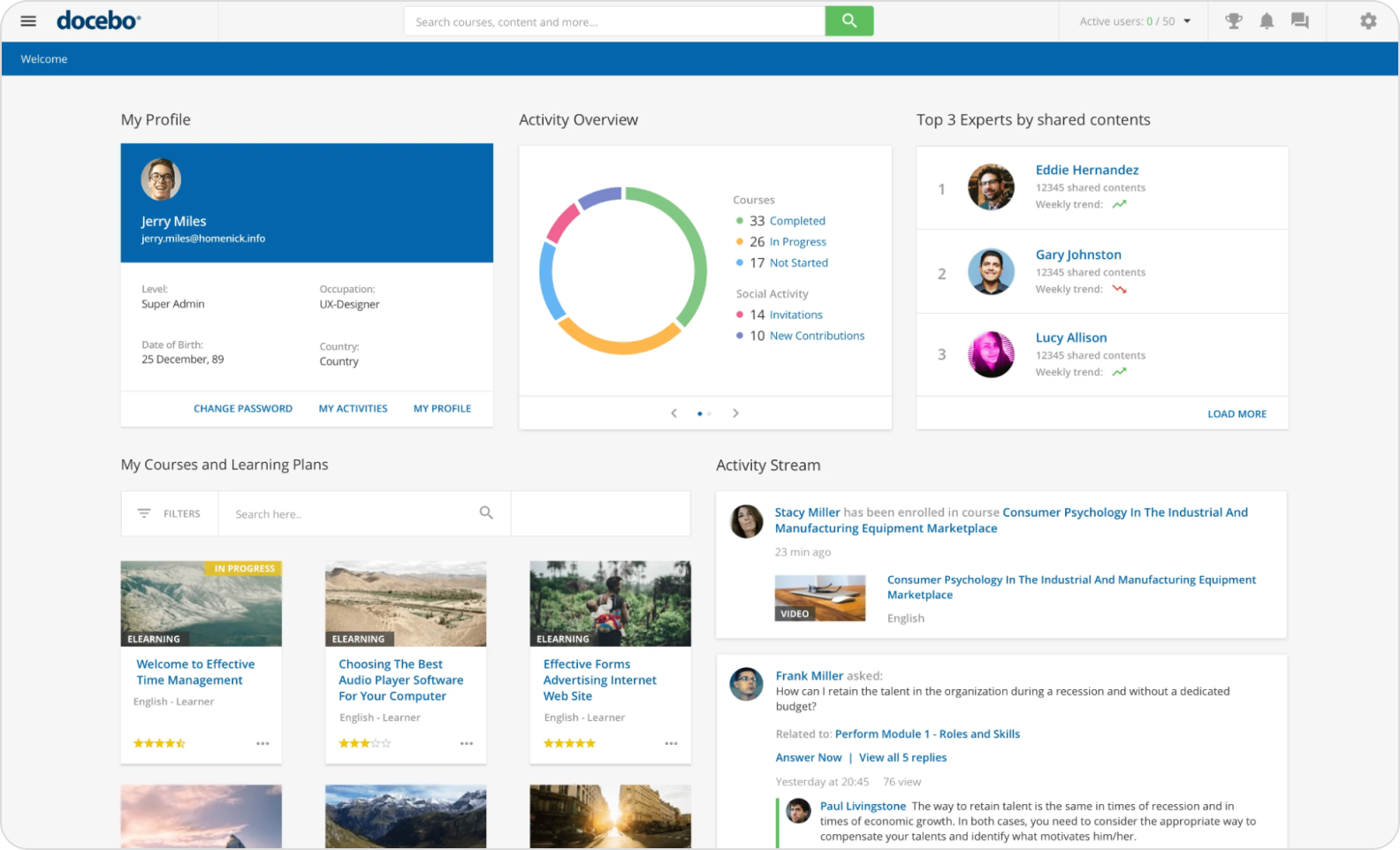
Why we picked it
Docebo presents a multi-product suite of learning management tools designed to cover the entire employee learning lifecycle, from content and course creation, management, and delivery to learning impact measurement.
The online employee training platform provides a catalog of thousands of pre-designed skills and roles and uses AI (artificial intelligence) to personalize learning. The built-in AI assistant identifies and tags specific skills within your learning content, automatically matches them to your employees’ roles, and assigns a tailored employee training program to individuals.
Docebo can also serve as your corporate social media, where internal experts can share meaningful content, and employees, in turn, can ask questions and learn from each other in the workflow.
Pros
- Convenient drag-and-drop interface that allows one to move blocks (widgets) and customize the learners’ portal view
- Unlimited cloud storage in all plans
- 400+ integrations with course creation tools, HRIS, SSO, SRM, messaging platforms, and more
- Social learning tools / collaborative learning features
- eCommerce
Cons
- The interface is a bit clunky at times and not very intuitive, especially in the mobile app.
- Custom and manager dashboards, eCommerce, and MS Teams integration aren’t available with the Engage plan.
- No free trial period.
Pricing
Docebo employee onboarding and training software offers three subscription plans: Engage, Elevate, and Enterprise. To get a quote, you’ll need to contact the vendor.
Best for
Docebo can be a perfect employee training tool for enterprises with training needs that exceed the functionality of standard employee training management software. You may want to consider this the best option if you run a lengthy employee training program and/or want AI-driven recommendations, gamification elements to make learning fun, and integrations with popular business tools.
Our hands-on take
While I couldn’t try out Docebo directly, user feedback highlights the ease of use and flexibility it offers when customizing the platform to fit their organization’s needs. However, some users have noted inconsistencies in the interface and a learning curve associated with certain features.
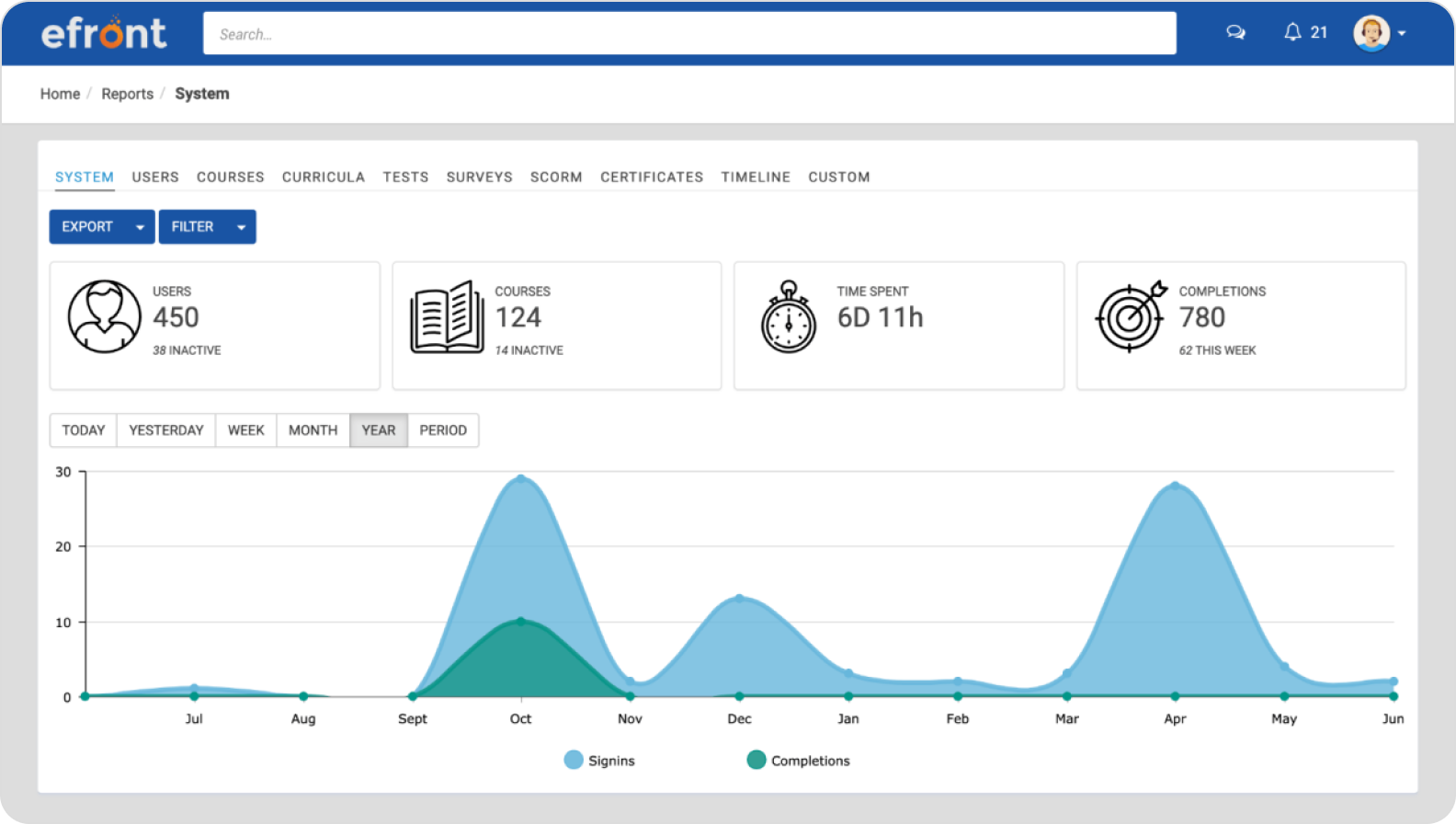
Why we picked it
eFront is an enterprise-focused employee development software with a rich feature list and customization options. It features everything that large organizations might expect from employee training management software, from content authoring and training management to automation and reporting.
This business training software allows you to create independent branches, conduct learner skill gap analysis, package related courses into curriculums, and provide tailored online training programs for employees and specific branches. If needed, you can seamlessly integrate eFront with your existing toolbox via API and fully customize the look and feel of both the learning portal and mobile apps.

Pros
- Multi-tenancy support
- SCORM 1.2, xAPI, and cmi5-compliant
- Native mobile apps for iOS and Android
- Dedicated CS manager in all plans
- Custom reports in all plans
- Cloud or on-premise installation
- ILT support
- SSO
- Available in 22 languages
Cons
- Can be expensive for small companies or startups
- Somewhat outdated interface
- No free trial
Pricing
With eFront, you can choose to pay for active or registered users:
- Registered (300+ registered users) — starts at $720/month.
- Active (100+ users that use your portal within a 2-hour window) — starts at $1,600/month.
Best for
eFront is certainly one of the best employee training software since it includes an impressive array of features designed particularly for medium and large enterprises. This is a great option for companies looking for fully customizable employee development software with high security standards.
Our hands-on take
Users frequently highlight its ability to create tailored learning environments, manage complex organizational structures, and deliver a blended learning experience. However, some note that the interface feels a bit dated and that the reporting features could be more intuitive.
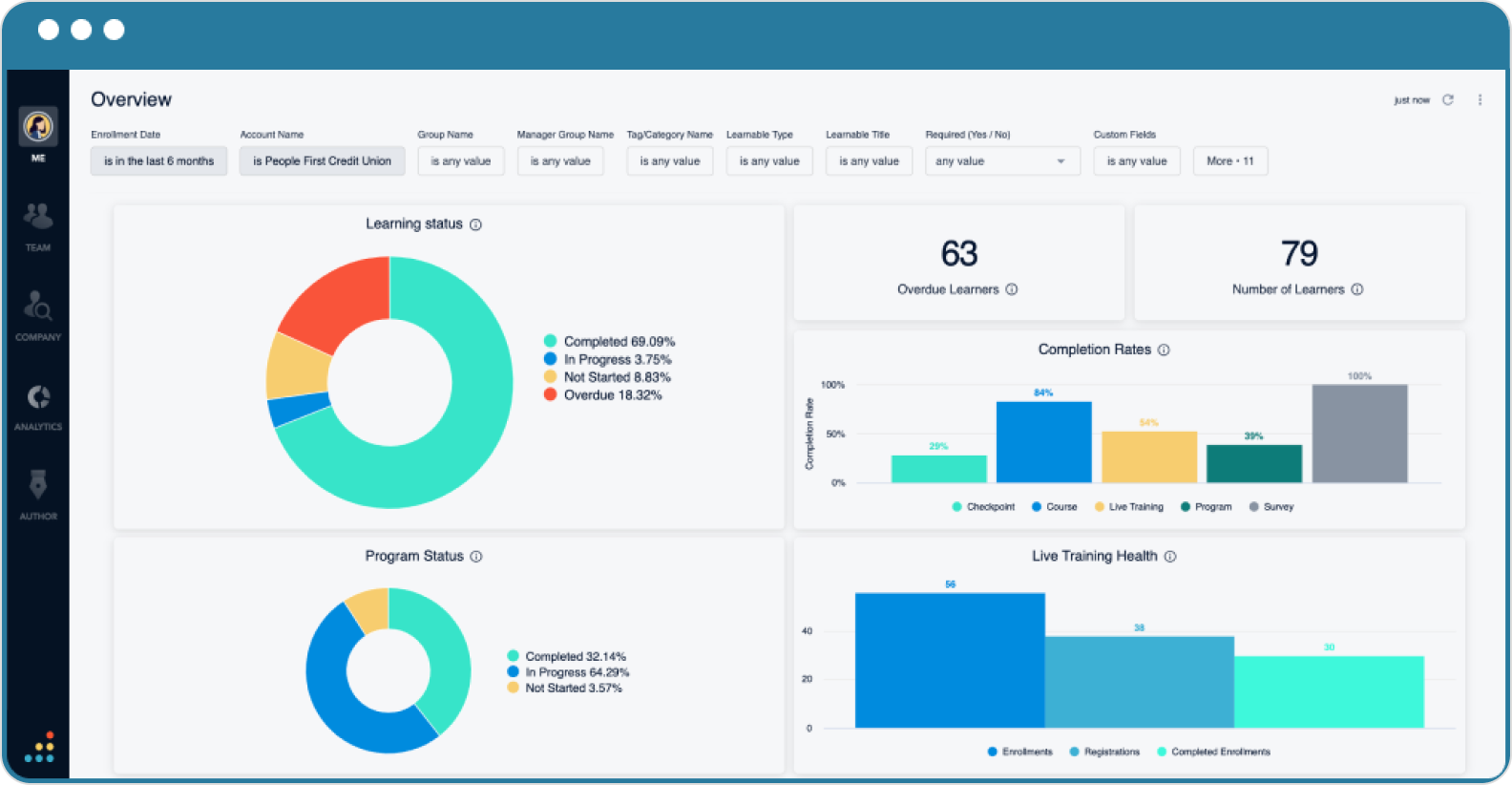
Why we picked it
Bridge is comprehensive employee training and development software that provides both learning management and performance evaluation. It offers good authoring capabilities, training automation, blended learning support, and an AI assistant that can automatically map skills to job roles and tag content with skills. As for training analytics, you can schedule and automatically distribute reports so your leadership teams are always informed of learning progress.
The employee performance module helps align each employee and team goal with the strategic objectives of an organization. You can also conduct 1:1 employee performance review sessions, develop manager coaching and feedback skills, define employee problem areas, and enable succession planning with the 9-box grid module.
Pros
- Off-the-shelf content right in the employee training management software (soft skills and compliance training topics)
- Native mobile apps for iOS and Android
- Intuitive course authoring directly on the platform
- SCORM compliant
- ILT support
- Integrations with HRIS, eCommerce, content providers, video hosting platforms, and SSO + open API
- Around-the-clock technical support
Cons
- One of the key differentiators, AI (artificial intelligence) skill development, requires an additional fee
- No on-premise installation
- Users complain about the unintuitive interface in some modules
- No customizable training completion certificates
Pricing
You can choose from three subscription plans, but Bridge doesn’t publish their prices:
- Learn — an LMS for creating, cataloging, and delivering training programs.
- Perform — a performance evaluation platform for goal setting, development plans, feedback, and more.
- Learn + Perform — a single tool for learning and development.
Best for
Bridge is the best employee training software for companies that want to launch complete training and development programs and need a single solution with training management and performance evaluation features.
Our hands-on take
The platform’s customer support is frequently praised for being responsive and helpful. Some users have noted areas for improvement, such as limited customization options and occasional system slowness.
Overall, Bridge appears to be a user-friendly employee training management software with strong support, although organizations with complex workflows and customization needs might consider it somewhat limited.
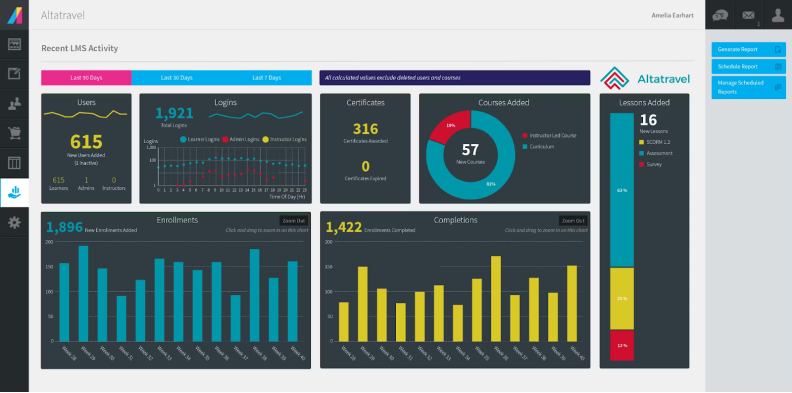
Why we picked it
Absorb LMS is one of the top AI-powered training software solutions designed for enterprises across all industries to train and upskill employees, customers, and partners. It helps organizations meet compliance standards, foster the organization’s growth through continuous learning, and monetize course content.
The core features of Absorb employee training and development software include learner and course dashboards, scheduled reporting, a turn-key content library, and seamless integrations. The platform supports automated enrollments, mobile learning, multilingual capabilities, and gamified elements like leaderboards.
Pros
- AI-powered tools (course builder, Intelligent Assist for task management, and intelligent recommendations)
- A built-in course authoring tool
- Powerful training automation features
- Customizable reporting and scheduling features
- Support for xAPI, SCORM, and AICC standards
- Integrations with third-party systems like Salesforce, Zoom, and BambooHR
- Access to a third-party course library
Cons
- Some aspects of the platform are not fully customizable
- Reports cannot be set for all managers
- Some users find the admin experience overwhelming
- Integration with third-party content vendors can be slow and cumbersome
Pricing
Upon request.
Best for
Absorb is one of the best employee training software for organizations seeking a strategic learning system that offers industry-leading support and a powerful yet user-friendly interface. It’s a comprehensive solution for employee, customer, and partner training programs.
Our hands-on take
I used a 10-day trial of Absorb LMS. Setting up courses and navigating the admin dashboard felt straightforward. However, I did find that some reporting features required additional configuration to extract the specific data I needed.
While there’s a slight learning curve with certain advanced features, the platform’s flexibility and responsive support make it a strong contender for organizations seeking a comprehensive LMS.
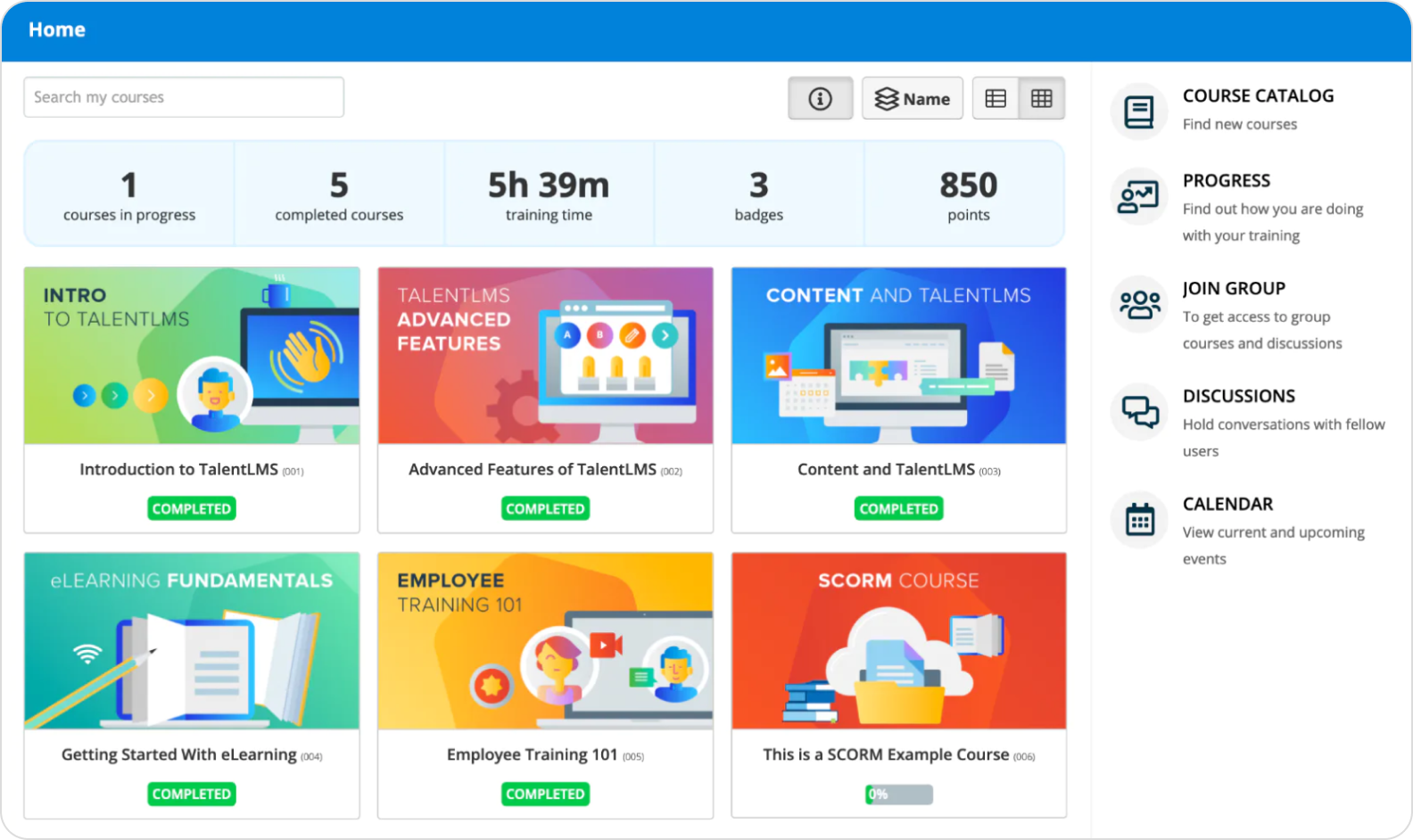
Why we picked it
TalentLMS is a training software for employees that’s designed with simplicity and usability in mind. One of its primary features is branches, which allows you to create independent training portals and train internal teams, franchisees, or partners separately.
This system allows you to schedule and conduct instructor-led training sessions (both online and offline) as an integral part of a course and conduct webinars using a built-in video conferencing tool.
Besides the core employee training management software functionality, TalentLMS shines with its social learning features. Instructors and administrators can create discussion boards, similar to discussion forums, to encourage debate among team members. They can also send messages to the entire branch, a group, or a specific employee.
Pros
- Multi-tenancy support (branches)
- Unlimited file storage, admins, and groups
- Native integrations with HRIS, CRM, calendars, Zapier, and other tools
- SSO using Google, Facebook, and LinkedIn accounts
- Content creation: tests, surveys, audio/video recording from a browser, document converter
- Employee training program reports in the form of visually appealing infographics
- Built-in eCommerce features to sell online courses
Cons
- Live chat support only with the Premium plan
- No security watermarks when uploading videos or PPT files from your computer
- No on-premise installation
Pricing
TalentLMS offers four types of subscriptions. If you pay annually, the quotes are:
- Core (up to 40 users) — $109/month.
- Grow (up to 70 users) — $229/month
- Pro (up to 100 users) — $399/month.
- Enterprise — custom plan; pricing available upon request.
The vendor also offers a free plan limited to 5 users and 10 courses.
Best for
TalentLMS is great employee training software if you want to train different types of audiences, such as employees, partners, customers, or employees from different business units, and even sell your online learning courses to external learners — all under one roof.
Our hands-on take
Setting up TalentLMS’s free plan was a breeze — I had a training portal live in minutes. I appreciate that TalentLMS’s free plan isn’t just a stripped-down demo but a legitimate slice of the full platform.
It echoes what many reviewers say: you get real value upfront, which builds trust. Knowing that I could use key features (not just sample content) and test out learning experiences leaves me more confident about scaling up with TalentLMS if my needs grow.
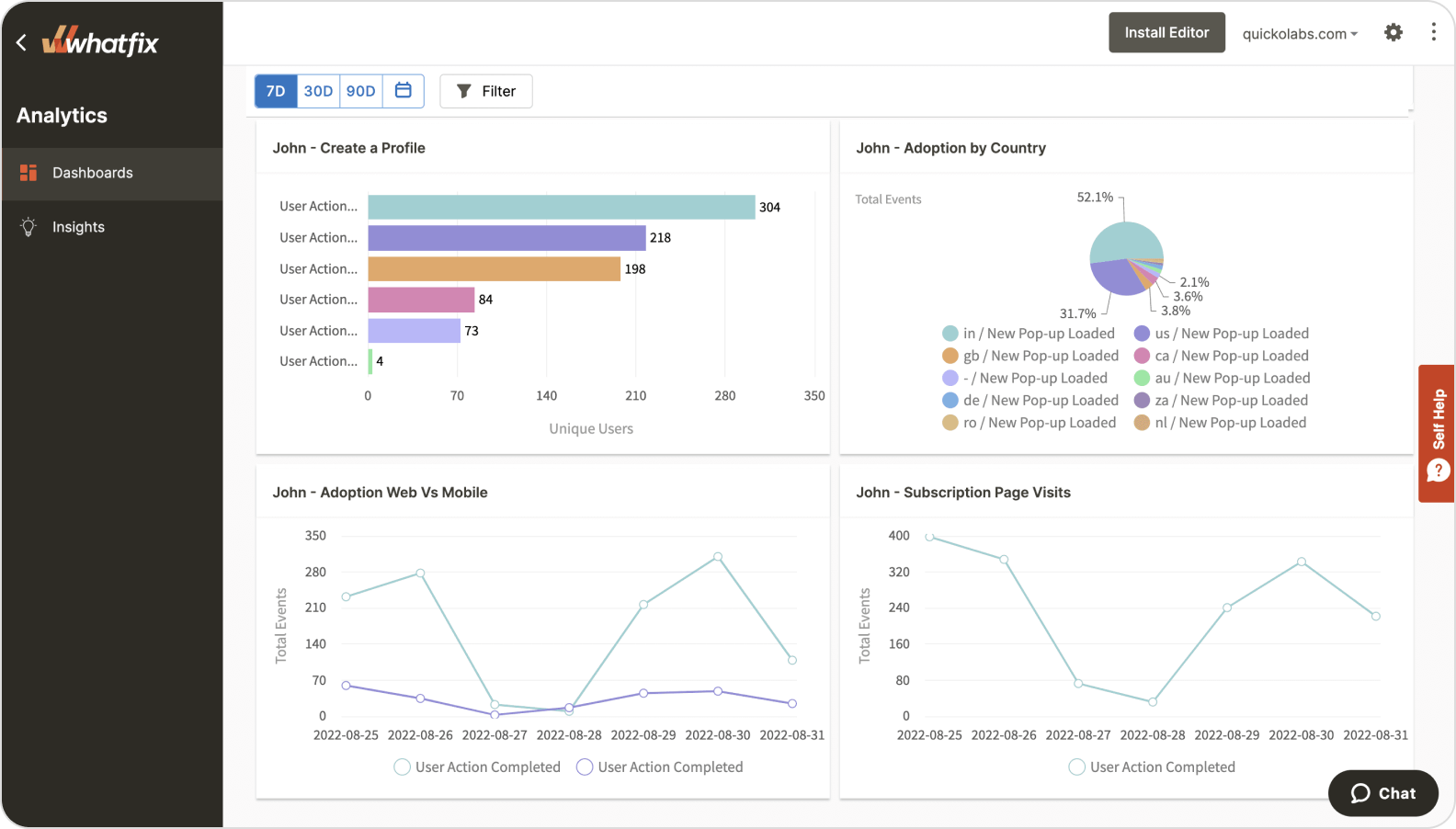
Why we picked it
Whatfix is an online training platform that allows organizations to create in-app, contextual training modules without any coding knowledge, which enables employees to master software programs on their own, without assistance from IT staff.
You can create interactive flows and guided tours within the apps, and show accurate navigation through smart tips, beacons, and customizable pop-ups. It’s also easy to create a self-help block consisting of text documents, web links, and other content formats that will appear on the appropriate page. With Whatfix employee onboarding training software, you can also create task lists and provide new hires with a roadmap of what they need to learn.
Pros
- Works in web, desktop, and mobile apps
- In-app code-free content creation
- Analytics that allows you to monitor the progress of workplace training programs
- The opportunity to create contextual guidance that’s segmented for specific user roles.
Cons
- The tool can be somewhat complex — some LMS features aren’t as easy to use as they seem when one signs up.
- Whatfix is probably not well suited for larger web apps that present users with multiple options to accomplish the task at hand.
Pricing
Upon request. There are three plans: Standard, Premium, and Enterprise. The price also depends on whether you need Whatfix for desktop or mobile devices. A free trial and a live demo are available.
Best for
This online employee training platform can be extremely handy for customer training in SaaS companies and onboarding new employees in enterprises where daily operations are powered by multiple software applications.
Our hands-on take
The interface felt overwhelming at first, but built-in guidance helped me get comfortable quickly. Creating my first walkthrough for technical skills training was easier than I expected with the no-code editor. I loved that I could build guides without any coding.
The only drawback was a slight learning curve, but overall I came away impressed with Whatfix in the trial.
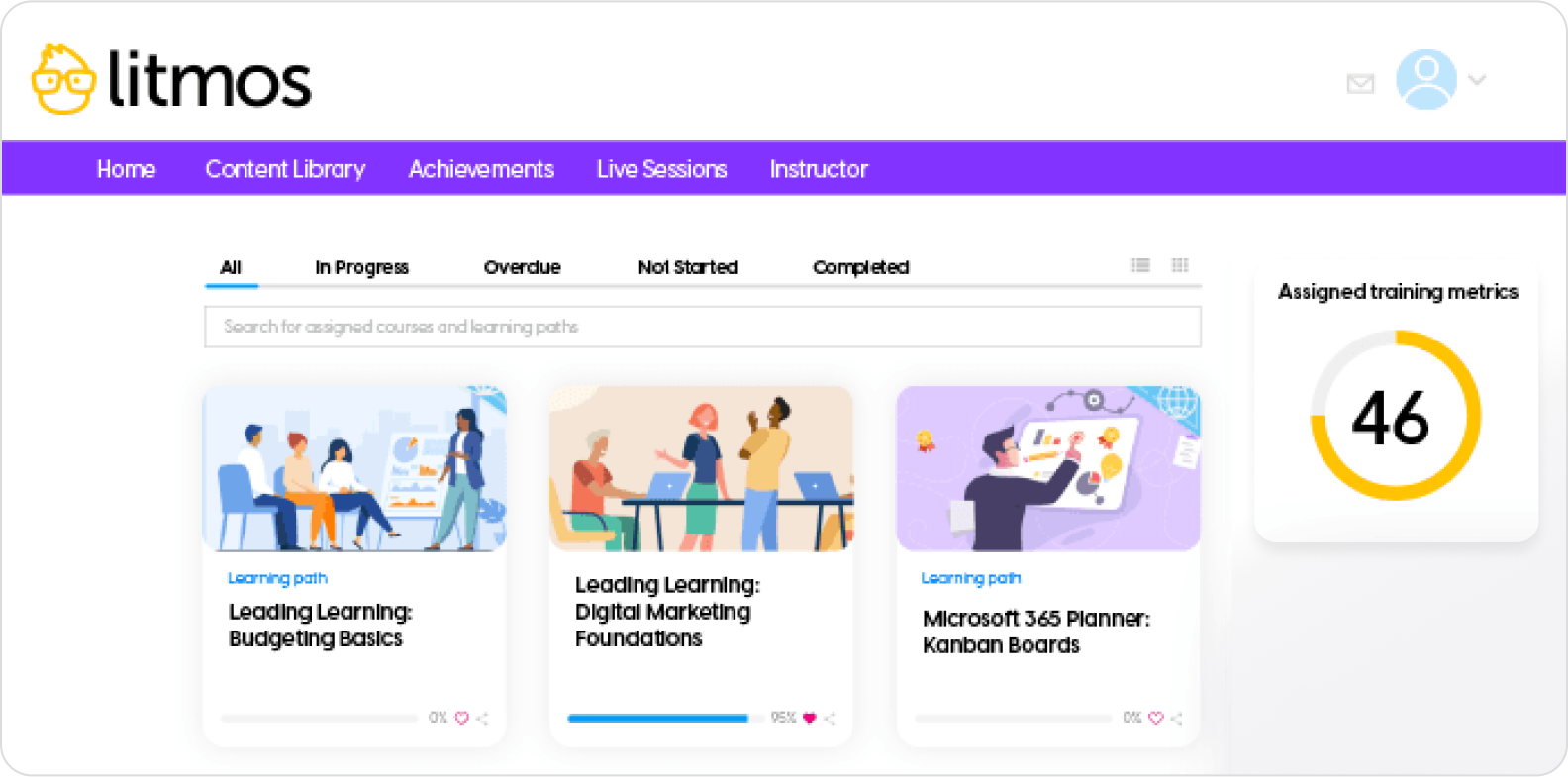
Why we picked it
Litmos is a corporate training platform with an attractive, easy-to-use interface. In addition to the standard functionality, there are video assessments. Learners can record and upload videos of themselves delivering communications, such as sales team pitches, and then the built-in AI scores them based on keywords (that should or should not be used) and speaking rate.
This online learning platform also offers a collection of over 2,000 online training courses for employees on topics ranging from finance and sustainability to customer service and online social presence. The library also includes customized compliance collections for the US, UK, Australia, and New Zealand.
Pros
- Ready-made video courses for personal and professional development with supplemental materials such as workbooks and handouts
- New courses added to the library every month
- 35 languages supported in each plan
- Native mobile apps for iOS and Android
Cons
- Not possible to create custom user roles
- Technical support isn’t always prompt, according to user feedback
Pricing
There are three plans: Foundation AI Suite, Premier AI Suite, and Platinum AI Suite. Custom pricing is available upon request.
Best for
Litmos is the best employee training tool for companies looking for highly intuitive staff training software with off-the-shelf courses. It will also be handy for conducting compliance training in the US, UK, Australia, and New Zealand.
Our hands-on take
I found the onboarding process to be quick and easy. I uploaded content and built a sample course in no time using its intuitive built-in authoring tool. The interface is clean and modern, making admin navigation simple. The learner view was similarly straightforward, with quizzes and gamification keeping it engaging. My only minor gripe was that pulling certain reports took a few extra clicks, but overall, it’s quite good.
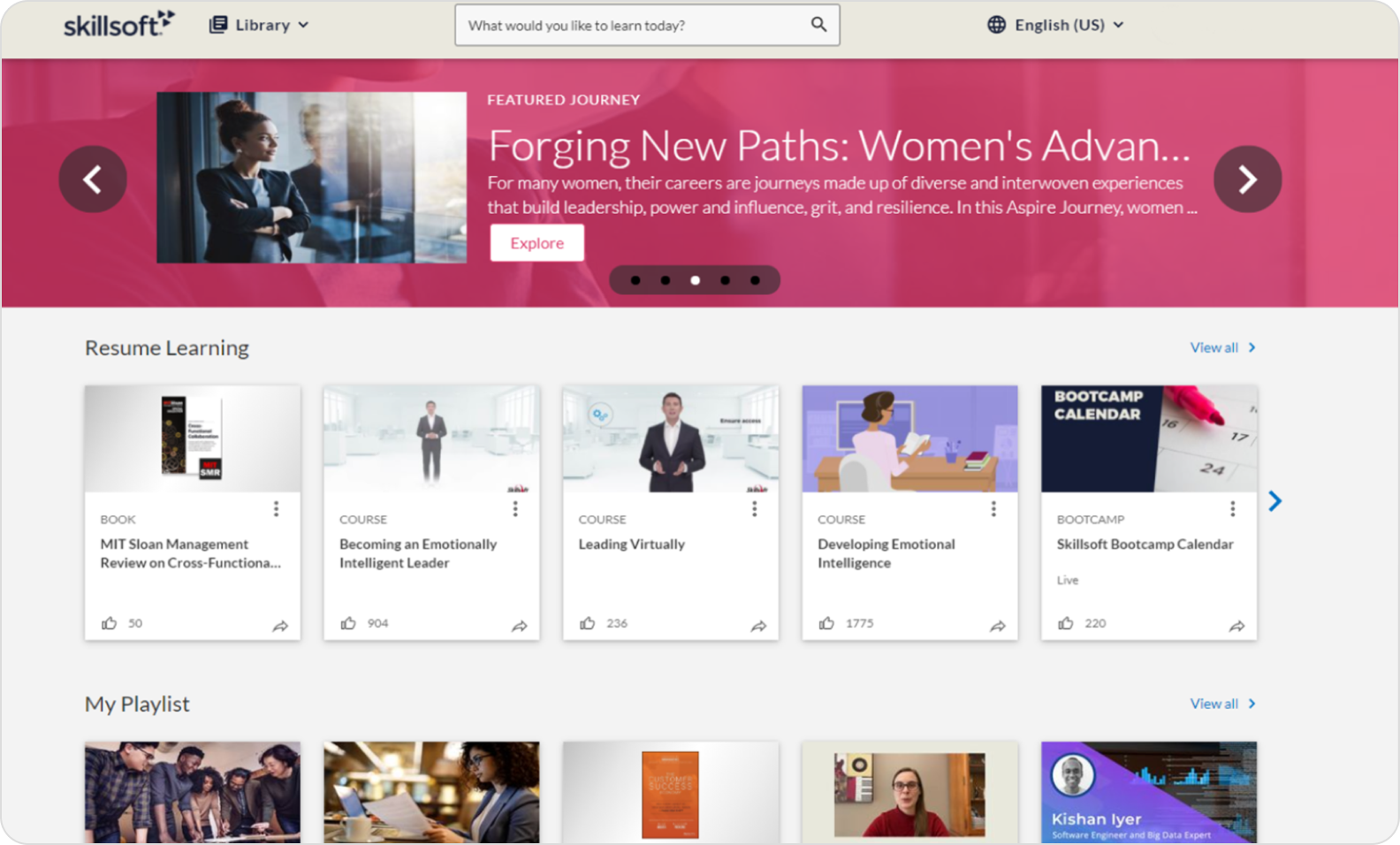
Why we picked it
Skillsoft is an online employee training software known for its extensive library of ready-made courses that you can integrate with your LMS platform or deliver workplace training through Skillsoft Percipio. This is an AI-powered employee training solution that offers over 17,000 customizable role- and skill-based paths and enables employees to choose what they want to learn from various in-demand topics, including leadership and business skills, tech proficiency, and more.
Skillsoft Percipio also features the Embedded Learning Synchronized Assistant (ELSA) — a browser plug-in that allows learners to highlight words in their messengers or browsers, search relevant eLearning content in the employee training management software, and learn directly in their natural workflow.
Pros
- Ready-made courses developed by industry leaders, subject matter experts, and renowned authors
- Executive dashboard with real-time data on the number of content launches, learning hours, and training completions
- Content format for different learning styles: users can initially choose from “watch,” “listen,” and “read”
- Personalized, continuous learning experience
- Many training programs are aligned with the compliance requirements or various professional certification exams, particularly in areas like IT and project management
Cons
- Compliance training programs are only available with the Enterprise plan
- Only 5 GB are available for your content in the Team plan
- Some courses may be a bit outdated
Pricing
Custom pricing. Upon request.
Best for
Skillsoft is great for companies looking for a platform with ready-made content to provide their employees with personalized learning paths tailored to their specific career goals and growth objectives.
Our hands-on take
The Skillsoft Percipio onboarding was smooth, allowing me to set my learning interests for personalized course recommendations and a tailored learning path.
The content library was impressively broad, from videos to books, and the interface was intuitive to navigate, although learning was mostly video-based and I missed interactive practice. Still, I came away impressed with Percipio’s breadth and usability.

Why we picked it
LearnWorlds is an AI-powered platform for online employee training and professional development designed to help businesses and entrepreneurs create and distribute online courses. The LMS places a strong emphasis on an interactive learning experience and provides numerous ways to create training material, such as courses, assessments, and video lectures.
You can create personalized training paths based on employee role and skill gap analysis, and then evaluate training ROI through 50+ comprehensive report templates. In addition to delivering L&D programs, this training software has everything you need to monetize your courses. It provides an intuitive interface, so you can create your cloud academy, even without any coding skills, and sell courses online.
Pros
- SCORM/HTML5 compliance
- eCommerce features for selling training programs
- Great authoring capabilities
- AI assistant in all paid plans
- Native mobile apps
- ILT classroom sessions support
- Integrations with financial, analytics, CRM, and video conferencing software
Cons
- Some crucial features – like training automation, white labeling, custom user roles, and learner groups – are only available with the Learning Center plan and higher
- Push notifications on mobiles and learner reminders come as an add-on
- There’s a steep learning curve in some areas, according to user feedback
Pricing
LearnWorlds offers three paid plans, all billed annually:
- Starter — $24/month.
- Pro Trainer — $79/month.
- Learning Center — $249/month.
A custom plan and a free trial are available.
Best for
LearnWorlds software for employee training is perfect for companies that primarily sell their online learning programs and educational materials online and want to onboard their new hires with a single learning platform.
Our hands-on take
I liked the clarity of the reporting dashboard, which allowed me to track the learner progress of my test group: I could see user engagement, course completion rates, and quiz results. Assigning courses to specific groups of learners was easy, although setting advanced permissions required an extra effort initially. Overall, LearnWorlds provided solid administrative capabilities for launching an employee training program.
FAQs on Online Employee Training Software
Here you’ll find some of the most commonly asked questions about employee training software:
1. Is employee training software the same as a learning management system?
These terms are related, but not exactly the same. Employee learning software is a more general term that can include any type of software that may not have the full range of management and tracking features that a learning management software does. While all LMSs are types of employee training software programs, not all employee training software can be considered full LMSs.
2. What is the difference between users and active users when it comes to pricing models?
In terms of software for employee training, “user” typically refers to any individual who has an account or access to the employee training solution, even if they only log in once a month or even less frequently. The definition of an “active user” can vary, but it often means someone who has logged in to or interacted with the software within a certain timeframe, such as the preceding (billable) month.
With pricing models of employee training software solutions, this distinction can be important. One employee training software may charge based on the total number of users, while another only charges for active ones. The latter model can potentially save companies significant amounts of money if they have many users who only need to use the platform occasionally.
Start with iSpring LMS
If you’re ready to explore employee training software options, consider starting with iSpring LMS. Book a free consultation with the iSpring learning manager: during a 20-minute call, we’ll discuss your training project, give expert advice, and show the iSpring LMS platform in action so you can decide if it’s right for your business needs.

